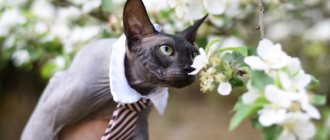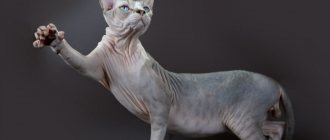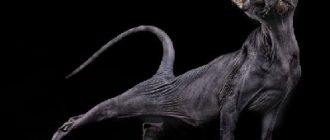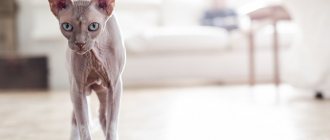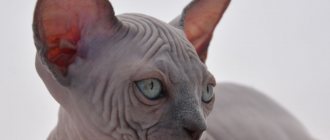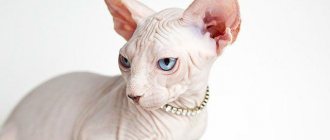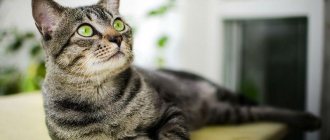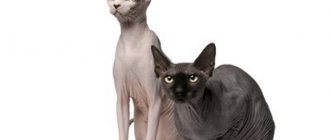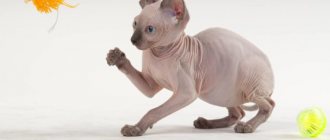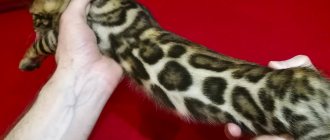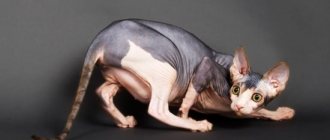The Sphynx is a hairless cat that evokes double feelings. Many are crazy about her unusual appearance, while others are repulsed by her alien features. In fact, a hairless cat is a gentle, friendly and sociable creature. But before you decide to get such a kitten, you need to learn everything about sphinxes - what to feed, how to raise and properly care for them.
Brief history of the breed
Hairless cats are the result of a natural mutation. In ancient times they were popular and lived in the court of the Egyptian pharaohs. However, then their trace was lost. History is silent about what happened to those hairless representatives of the cat world.
According to some reports, until the 20s of the 20th century, there was a population of hairless cats in South America. These animals had an unusual appearance - a bald body, which was partially overgrown with hair only in the cold season, and large, expressive eyes of an amber hue. The South American breed of hairless cats has completely disappeared from the face of the earth, so its genetic characteristics cannot be studied.
In 1966, a hairless kitten appeared in one of the provinces of Ontario, Canada. The owner of a black and white short-haired cat discovered in her litter a baby completely different from the rest. He was bald and wrinkled, so his owner gave him the name Pruni, which means “prune.” When the hairless kitten grew up, the woman crossed him with his mother. It was not possible to achieve complete consolidation of the signs - hairless cats were found in only a few litters.
A few years later, 2 hairless cats were born in Minnesota, USA. Then active breeding work began. Hairless cats were crossed with representatives of other breeds. However, the best results were achieved when breeders used Devon Rex.
For a long time, felinologists did not recognize sphinxes because they feared that the mutation could provoke the development of serious diseases. Only in 1986 did TICA give the go-ahead for the participation of hairless cats in exhibitions and championships. Later this was done by the CCA and CFA organizations. The breed was called the “Canadian Sphynx”.
Origin story
Mentions of hairless cats can be found in the chronicles of different nations. This is due to the fact that a hairless kitten could appear from completely ordinary parents. Initially, such unusual kittens were considered discarded.
Reference! The appearance of the Sphinx is considered a natural mutation.
Officially, the birth of the breed is considered to be 1966. Then in Toronto (Canada) a domestic cat gave birth to a hairless kitten. The cat's owner gave the baby the name Prune (Prune). At the same time, sphinxes began to appear in nurseries.
Initially, the kittens were called “Canadian Hairless Cat,” but not everyone liked such a long and ordinary name. Fans of hairless cats were looking for a euphonious name for the breed and drew parallels with the oldest surviving sculpture - the Egyptian Great Sphinx.
Interesting Facts
For those interested in Sphynxes, here are a few facts about these cute cats:
- They have an excellent appetite, as their body quickly gives off heat.
- Hairless cats come in different colors and even patterns on their bodies in the form of spots or stripes.
- Although the Sphynx seems too hot, its body temperature is almost the same as that of representatives of other breeds, only 0.5 degrees higher.
- A hairless cat can easily learn to open door handles and perform other manipulations.
- The Canadian Sphynx is not suitable for allergy sufferers.
Who is not recommended to start
Canadian Sphynxes are quite unpretentious animals and can find the key to the heart of any person, however, there are features that you need to pay attention to before buying a hairless baby.
- Allergy . If you suffer from an allergy to cats, then even a hairless pet will not save you from it. In most cases, the allergen is cat protein, which is found in saliva, sweat and feline waste. And Sphynxes sweat all over their bodies, unlike other breeds!
- Lack of time for care . The need to bathe your pet weekly will raise serious doubts for some people. If you want a cat that doesn't require any maintenance, then the Sphynx is not for you.
- Frequent absence from home . Sphynxes are attached to their owners, so a prolonged absence of human communication is always stressful for the pet. You should not choose a Sphynx as a pet if you lead an active lifestyle outside the home.
Of course, caring for a pet will be different from caring for a cat with a wool coat. However, it is not as difficult as it might seem at first glance - the main thing is to follow the basic rules.
Wool
Increased body temperature also affects the animal's sweating - sphinxes sweat a lot. Sweat has a rather specific smell, so caring for your pet's skin should be regular - bathe it once a week and wipe it with a damp cloth as needed. If you neglect skin care, a gray coating forms on it - a mixture of dirt, sweat and sebum.
Reference! It is better to take wipes and shampoo that are hypoallergenic and fragrance-free. You can choose children's ones so as not to provoke irritation on your pet's delicate skin.
You should bathe only in warm water, after which you must wrap it in a terry towel, otherwise the baby may freeze and catch a cold.
Nutrition
Due to their elevated body temperature, Sphynx cats have an accelerated metabolism. Therefore, they need to eat more than representatives of other breeds. The Sphynx should be fed no more than twice a day, preferably at the same time.
Important! Obesity is a common disease among Sphynx cats. You should not feed your pet every time he asks.
There are two main nutritional concepts, from which each owner chooses the most suitable:
- Natural food (meat, sea fish, dairy products). In this case, you need to add vitamins to your diet. Also try to minimize the amount of fatty foods, as they are harmful to your pet. Meat should be given only in the form of pieces, and not minced meat, which will ensure the cat has healthy teeth.
- Ready food . If you prefer ready-made food, pay attention to its quality. To ensure a balanced diet, you should purchase super-premium food and higher.
Important! Remember, extensive advertising of a product is not at all a sign of quality - first of all, pay attention to the composition of the food.
When choosing any food concept, do not forget that your pet should always have a bowl of clean and fresh water.
Caring for ears, eyes, claws
Sphynx cats, like other cats, can accumulate dirt between their claws and in their ears, which cats of other breeds cover with a fluffy coat.
- Ears . The secretion accumulated in a pet's ears does not pose a danger and does not interfere with hearing, but outwardly it does not look aesthetically pleasing. You should clean your pet’s ears like a small child – with a cotton swab (not a swab), carefully and slowly.
- Claws . In addition to regularly cleaning the dirt between the claws, it is worth paying attention to the claws themselves - trimming them will help the owner keep the furniture in its original form.
- Eyes . It is also necessary to monitor the condition of the eyes to avoid various infections. You can wipe your pet's eyes with green tea or chamomile decoction using a cotton swab.
Walking your pet
Some experts agree that the Sphynx is exclusively a domestic animal. However, to provide your cat with physical activity, it is possible and even beneficial to take him for a walk, but no more than 1-2 times a week.
Important! You can only take your pet for a walk in warm, dry weather.
Sphynxes love to soak up the sun. Tanning (yes, hairless cats can tan too!) causes their thin skin to slightly change pigment - bronze shades appear, as well as freckles and spots.
Important! Do not leave your pet under the scorching rays of the sun - severe burns may occur on its delicate skin.
In general, it is enough for a cat to install a high scratching post and buy several toys. Sphinxes especially love pointers with feathers tied to them and running mice running on batteries.
Useful video:
Breed description, standards, appearance
The main feature of the sphinx is its naked, strong body, covered with folds, large ears like locators, and huge eyes. It is very pleasant to stroke such a cat - its skin resembles soft suede.
Dimensions and weight
According to the official description, the Canadian Sphynx is a medium-sized cat with well-developed muscles. The average height at the withers is 30-35 cm. The weight of an adult Sphynx cat is 4-6 kg. Females are lighter and more graceful, their weight does not exceed 4.5 kg.
Anatomical characteristics
There are strict requirements for the appearance of sphinxes. According to the approved standard, cats should look like this:
- The head is medium-sized and has a wedge shape with smooth outlines.
- High cheekbones, strong chin.
- The frontal part of the Sphinx's head is flat, the muzzle is short.
- The ears are rounded at the ends and have a wide base. The outer edges extend slightly beyond the line of the head.
- The cat's whisker pads are convex, and the whiskers are either absent, curled or broken.
- Large oval eyes are located at a considerable distance from each other. The cat's gaze is a little slanted.
- The neck is quite strong, of medium length, smoothly turning into a wide, rounded chest.
- Muscular, strong body of medium length with a full belly.
- The length of the limbs is proportional to the body. The front legs are slightly shorter than the hind legs.
- Paws are oval with thick toes.
- The tail is long, thin, gradually tapering to the tip.
- Canadian Sphynxes have thick skin, which gathers into numerous folds on the head and neck.
Color and coat type
The colors of sphinxes are varied. They are determined by skin pigmentation and are:
- Plain. This group includes: black, white, blue, cream, lilac, red (red) and chocolate. Blue (gray) is a lightened version of the black color. If a Sphynx has pink skin, it means it is white.
- Two-color. They combine any color with white. The pigmented part of the skin should contrast against a light background. A mandatory requirement for a bicolor cat is that one ear must be colored.
- Color point. Kittens are born pink, but after some time they develop a dark mask on their nose, ears, paws and tail.
- Tortoiseshell. This color of the sphinx combines 3 colors - white, black, red. It occurs in females and males, but tortoiseshell cats cannot reproduce.
- Less common types of colors are van, tabby, harlequin, tonkin.
Although sphinxes appear to be completely naked, in reality they are not. Cats have fine hairs no more than 2 mm long on their bodies. Short and sparse hair is present on the outside of the ears, on the underbelly, between the toes and on the tail.
Possible breed defects
The disadvantage of the Sphynx breed is the presence of hair on those parts of the body where it should not be, as well as the length of the hairs is more than 2 mm. Other exterior defects:
- thin bones, graceful forms;
- underdeveloped muscles;
- straight profile;
- long and too narrow muzzle;
- small ears.
Attention! The body type of the Canadian Sphynx should not be similar to Devon Rex, Cornish Rex or Oriental cats.
Solid color
The different shades of sphinxes are actually the skin's own pigmentation and a thin layer of mossy down. When exposed to sunlight, a cat may tan and its color will become brighter.
Let's look at the main types of Sphynx colors:
| Black | The tone of the Canadian Sphynx is black and one-level. The skin of the nose is black, the skin of the paw pads is black or brown. |
| Blue | Shimmers from blue to blue. The nose and paw pads are dark blue. |
| Red (Red) | Deep shade, rich, brilliant red-red color. The lips, chin, nose and paw pads are red brick. |
| White | The color shimmers from white to pink. The nose of the white Canadian Sphynx has a pink tint, and the pads of its paws are the same color. |
| Cream | Single level cream shade. The skin of the nose and paw pads is also pink. |
| Chocolate | Chestnut-chocolate, rich color. The nose and paw pads are brownish. |
| Lilac | The shade is grayish with a mauve tint. The nose and paw pads of the Sphinx are pinkish-lilac. |
Types of Sphynx cats
The Sphynx breed is represented by three species. In addition to the Canadian one, there is also the Don variety, which was bred in Rostov-on-Don, and the Peterbald - the creation of breeders from St. Petersburg.
The Canadian Sphynx is smaller than the Don Sphynx. The standard for this breed was approved in 1992. The Peterbald was obtained by crossing the Don variety with Oriental cats about 20 years ago.
Differences between the Canadian, Don and St. Petersburg sphinxes
The Canadian Sphynx became the first breed to officially recognize hairlessness as a standard. The Don Sphynx and Peterbald are related breeds whose homeland is Russia. The St. Petersburg Sphynx appeared as a result of crossing the Donchak and the Oriental cat.
Visual differences in the structure of the muzzle of these three breeds are clearly visible in the photo below.
| Petersburg Sphinx | Canadian Sphynx | Don Sphynx |
| Elongated, elegant body with well-developed muscles and a long neck. Long straight tail, slightly tapering to the tip. | Average build with a round belly. Wide chest. Large paw pads Thin whip-shaped tail | Strong medium to large bone, prominent belly Straight, medium length tail |
| The shape of the head is an equilateral triangle, an elongated profile with a clear line connecting the tip of the nose and the chin. Flat forehead, long nose | The head shape is wedge. There is a hollow on the bridge of the nose. Well defined cheekbones, short profile | Wedge-shaped head with a firm chin. Straight nose, elongated profile, but shorter than Peterbalds |
| Almond shaped eyes | Lemon eye shape | Almond shaped eyes |
| Triangular ears with a wide base, set apart | Large erect ears, rounded at the ends. Wide head stance | Large ears with a slight forward tilt |
| Elastic skin with small folds on the neck, abdomen, folds of the paws and head | Thick skin with numerous large folds throughout the body | Most folds are located on the head, abdomen, groin and armpits |
Character and temperament of the Canadian Sphynx
Sphynx cats have high intelligence and a good-natured disposition. One of the main features of their character is their strong attachment to their owner. The pet follows him everywhere and willingly takes part in all activities. As soon as the opportunity presents itself, the cat will immediately sit next to you.
The Sphynx cat loves to climb on the shoulders or chest of the owner, closer to his face, rub against his owner's nose and purr softly. This is how they show complete trust. Sphynxes also love to talk.
A hairless cat cannot be left alone for a long time; it constantly needs communication and affection. Representatives of this breed become strongly attached to the members of the family in which they are raised. A long separation from the owner will be a real test for the Sphinx. Those who are forced to frequently go on business trips are not recommended to have such a cat.
Sphynxes are completely devoid of aggression, so you don’t have to be afraid to leave them alone with small children. A pet will never offend a child, even if he accidentally hurts him. Sphynxes get along well with other animals - small dogs, rabbits and cats of other breeds. Their hunting instinct is poorly developed, so they can be kept together with parrots, canaries or domestic rats.
Sphinxes feel comfortable even in a crowd of strangers if their owner is nearby. This character trait allows them to relax and show themselves in all their glory at the exhibition.
These are very smart cats. They easily remember commands, get accustomed to the tray and scratching post, and pick up the intonation of the owner. It may seem that the sphinx understands everything perfectly. You should not be rude when communicating with him, as he is extremely gentle and vulnerable. An offended cat will not take revenge, but someone who mistreats her may lose her trust forever.
Character of the sphinxes
Not all sphinxes are the angels that breeders sometimes try to make them out to be. Much depends on the conditions of detention and the correct behavior of the owners. And most importantly, it depends on how compatible the temperaments of the sphinx and the people with whom it lives are. At the end of the section you will see a table that clearly shows that the same character trait can be both a plus and a minus.
Sociable
If you think that a cat should be independent and inconspicuous, the Sphynx is not for you. This breed is famous above all for its desire to communicate. The Sphinx is always next to its owner, no matter what he does.
Hello, do you need any help?
Baby yoga, or rather cat yoga
These cats climb on your hands at every opportunity, and can jump on your shoulders if you don’t wean them off. They spin around under your feet and actively help in everyday life - they throw themselves on a floor rag, take away your toothbrush, and chew on the pen you are trying to write with.
In addition to physical contact, the sphinx communicates through “talking”. Canadians meow a lot and willingly, and in different ways, depending on the occasion.
Active
The Canadian Sphynx is a real energizer, especially when young. This cat needs active games. The Sphynx can chase a teasing rod until he becomes out of breath, which is definitely not what you would expect from more phlegmatic breeds like the British.
A naked kitten is often called a monkey in people's hearts - not because of its external resemblance, but because of its endless pranks. A Canadian Sphynx left unattended can turn an apartment upside down. Perhaps only Abyssinian or Bengal cats can surpass them in activity.
What are you looking at, turn back!
Kittens are very active and always ready to play
Affectionate
One of the advantages of the Canadian Sphynx is their love of love. They always readily respond to affection, and they themselves demand attention, butting and rubbing themselves against their owners. In case of conflict, the Sphinx prefers to run away and hide rather than engage in open confrontation. This breed is not characterized by aggression.
You smell like chicken, can I lick you?
Curious
Even if the sphinx does not leave the apartment, it will continue to explore the space again and again. It is very important to install protective screens on windows and remove wires and other hazards from access.
There's nothing interesting in the closet, I checked
Gluttonous
Sphynx cats have an intense metabolism and require more food than a regular cat of the same size. You'll be surprised how much one naked cat can eat if you give it free rein. Owners laughingly describe how the cat puts its muzzle right into their mouth in the hope of begging for a tasty morsel.
Give me something tasty, man!
Canadian Sphynxes have developed intelligence, which is confirmed by the stories of their owners. One woman's cat learned to turn off her computer because she picked him up and pet him when she rebooted the computer. In another, he rang a special bell with his paw, demanding food. The Sphynx can be trained simply by observing it and rewarding certain behaviors.
Treat the sphinx!
Touchy
The Canadian Sphynx cannot be punished. The cat won’t understand why, and you’ll make the problem worse. If your kitten scratches your legs while trying to climb up, you shouldn't spank him. You should not poke a cat into a puddle made in the wrong place, even if it was your pillow.
We invite you to familiarize yourself with the Musk turtle: description, keeping at home, photo
Sphynx cats are gentle and affectionate cats, but their trust is easily destroyed by impulsive actions. If you are taking a naked kitten into your home, you better be patient in advance.
Glass left unattended - shared
Character Trait Plus-Minus
| Sociability | A sociable and affectionate pet, a lot of positive emotions. | Does not tolerate loneliness well, can be intrusive and disturb. |
| Curiosity | Sphynxes are not cowardly, they make contact with other animals, adapt when moving, and love to learn new things. | They climb into places they shouldn’t, which can lead to injury – a window, a washing machine, a dresser drawer. |
| Voracity | The pet will not be picky, willingly gobbling up the food that you offer it. | Due to the constant feeling of hunger, sphinxes are prone to begging and theft, and if they are overfed, they become obese. |
| Friendliness | The Sphinx is a good companion for children; it is unlikely to bite or scratch unwary children. | If you pay little attention to your sphinx, he will experience stress. The pet needs to be petted a lot. |
| Activity | The cat is always ready to play and will not let you get bored, charging you with its energy. | People often mess around at home - they scratch furniture and curtains, throw things off, and destroy indoor plants. |
You don't need to study, pet the cat!
The absence of wool is convenient for owners, but imposes additional obligations on them. The Canadian Sphynx cannot be called a sissy, but still these cats are demanding in terms of living conditions.
The basic needs of the Canadian are the same as those of ordinary cats. The pet needs to be vaccinated, given anthelmintic and provided with adequate nutrition. Sphynxes have an excellent appetite. They can be fed both high-quality industrial food and home-cooked food. The diet must be balanced, otherwise the Canadian will develop skin problems and digestion problems.
This tortoiseshell cat eats like a pig. But not with milk, but with kitten formula.
Hairless cats spend a lot of energy heating their bodies. They eat a lot and therefore poop a lot. Sphynx owners often complain about the particular odor of the tray, but well-selected litter and regular cleaning solve this problem.
All Canadians have a tendency to gluttony. After sterilization, they are limited in food to avoid obesity.
You can see what a fat Sphynx looks like and be horrified HERE.
Adult Sphynx: an abundance of folds is a sign of an outstanding breed of animal
Specific care points include:
- Eye treatment;
- Ear cleaning;
- Bathing.
Because Sphynx cats do not have eyelashes, they produce more tears than regular cats. Jelly accumulates in the corner of the eye, which turns brown as it oxidizes in the air. These secretions need to be removed with a damp pad every day.
You go to work, and I’ll sleep a little here!
The Sphynx's skin "sweats". Brownish grease accumulates on it. It may be more or less depending on the action of hormones, the animal’s diet, and the time of year. If the Sphynx is not bathed, a brown coating remains on the hands, furniture, windowsill - everywhere.
You need to wash your cat with a special shampoo, and not too often. The owner himself sets the frequency of hygiene procedures, usually 1-2 times a month.
The Sphynx has been taught to bathe since childhood, but not all cats love this procedure.
The same brown plaque accumulates in the ears. If in an ordinary cat dark discharge in the ear indicates a disease, then for a Sphynx this is the norm. The ears are cleaned with lotion and a cotton pad, about 1-2 times a week.
To prevent the cat from injuring itself or its owners with its claws, they are trimmed with a nail clipper 2 times a month. While bathing, wipe the nail bed to remove brown discharge.
Check out my gorgeous nails, man!
The unique character of the Sphynx, as well as their appearance, is the result of careful selection. These animals are not prone to displaying aggression or discontent. Kind, soft, sensitive, gentle, devoted Sphynxes are ideal pets.
They get along well with both older people and families with small children. A balanced character combined with a playful disposition helps these animals share the interests of each family member.
Sphynx cats get along well in families with small children.
Sphynxes love to interact with people and pets. They are not afraid of large dogs and lack the hunter's instinct, so a hairless cat's best friend can be a huge bulldog, a hamster or a parrot.
Sphynxes are playful and curious animals.
Even Sphynx kittens look majestic and proud, their entire appearance reminiscent of Egyptian figurines. Calling the Sphynx a simple cat name, such as Timka or Fluff, doesn’t even occur to us.
In order not to invent anything new, you can simply look at the list of names of Egyptian gods. A name suitable for the little miracle will be found there quickly.
For example, a Sphynx cat can be named after one of the goddesses: Amaunet, Anuket, Isis, Seshat, Sioux. Suitable names for a sphinx boy are: Aker, Amat, Amset, Anhur, Geb, Mafdet, Onuris, Osiris, Hapi, Hesat, Khnum, Shai, Yah.
The names of ancient Egyptian gods suit the majestic sphinxes.
The main feature of keeping sphinxes is the need for regular bathing. Bath procedures are carried out at least twice a month.
Adult cats are bathed in a bathtub, kittens - in a basin or sink. Soapy bathing water should not be cool - sphinxes need warmth.
Adult Sphynx cats are bathed in a bathtub
Using a soft washcloth, carefully remove dirt from the body, face, tail and paws, paying special attention to the folds, then rinse the animal in clean water.
If the sphinx is not against bath procedures and enjoys playing in the water, you can offer him children's rubber toys. If the animal is frightened and is trying with all its might to avoid the upcoming procedure, you should talk to it in a gentle, calm voice.
Sphynxes love to play while bathing.
However, you should not make sudden movements or raise your tone. After bathing, the cat is “blotted” with a dry, warm cotton towel. In addition to bathing, hairless cats need to be dried daily with soft wipes.
We invite you to familiarize yourself with the varieties of the Jack Russell Terrier, Parson and Brocken breeds, their descriptions and photos
Sphynx cats need regular manicures, as brown sweat mixed with dirt quickly covers the top and gets stuck inside the overgrown claws.
The ears of sphinxes, as well as their claws, suffer from a large accumulation of fat and dirt in them. You can clean your cat's ears using cotton swabs or turundas moistened with warm water. Contaminants are removed only from visible parts of the ear, avoiding contact with the ear canal.
Sphynx ears need to be cleaned regularly
How to choose the right kitten
When choosing a purebred kitten, there is no need to try to save money. It is better to buy a four-legged friend from a nursery with a good reputation. The breeder is responsible for each animal he sells, so he will not cheat. Kittens are sold with all documents - veterinary vaccination certificates, pedigree, passport.
Before buying a Sphynx, it is advisable to get to know his parents better, because later the baby will look like them. For those who do not intend to continue breeding hairless cats, a pet-class pet is suitable. This is a healthy cat that has minor conformation defects and therefore cannot participate in breeding work. Such sphinxes are cheaper and are bred solely for maintenance.
Kitten care
There are 3-5 kittens in a cat's litter. They are born blind. Babies' eyes open around the 3-4th day. In the first weeks after lambing, the mother takes care of the babies. She feeds, washes and warms the cubs with her body.
A month later, the sphinxes are given their first complementary foods. You can give low-fat cottage cheese or boiled lean chopped meat. Until the age of three months, cats are fed 6 times a day, then they are transferred to four meals a day. Adults eat in the morning and evening.
Small Sphynx cats require special care. It is important to keep your skin clean, as it quickly becomes oily. Once a week, the cat should be washed with warm water without soap, and wiped daily with wet wipes. The eyes and ears of naked cats are carefully cleaned with cotton pads soaked in a special product.
How to care for a Sphynx
Since the kitten has no hair and does not need to be brushed, it may seem that the care and maintenance of the Canadian Sphynx requires minimal care, but this is not so.
Hairless cats sweat profusely, all over their bodies. They produce a large amount of secretion from the glands and it does not look aesthetically pleasing. They need to be wiped with a damp cloth or bathed, otherwise a dark coating will appear on the skin.
The time of year affects the conditions in which cats are kept. You need to make sure that your pet doesn’t get sunburned or catch a cold from drafts.
Caring for your Sphynx includes maintaining optimal temperature and humidity in the house. If the air is too dry, the skin of cats begins to peel off, and ulcers can even form.
The eyes of hairless cats do not have eyelashes, so they are susceptible to frequent diseases; it is necessary to clean them of secretions. Mandatory care should include brushing teeth and ears.
Feeding the cat
Hairless cats have faster metabolic processes than other breeds. They need more calories to maintain their body temperature.
Complete diet
When feeding dry formulas, preference is given to super-premium or holistic food from the following brands:
- Hills;
- Royal Canin;
- Acana;
- Pro Plan.
Some cat owners choose natural food for their pets. In this case, the Sphinx’s diet includes:
- lean meats - rabbit, veal, turkey, chicken;
- sea fish;
- cereals cooked in water without salt - buckwheat, rice, oatmeal;
- fermented milk products – low-fat cottage cheese, yogurt, sour cream;
- vegetables that have undergone heat treatment - carrots, broccoli, spinach;
- quail or chicken eggs (no more than 2 times a week).
Sphynx cats should not be fed processed foods, sausages, snacks, smoked meats, sweets, pork, bones and potatoes.
Feeding frequency
Adult cats are fed 2 times a day - morning and evening. During the daytime, you can treat the sphinx with a small piece of treat. Small kittens should eat more often:
- from 1 to 3 months – 6 times a day;
- from 3 to 6 months – 4 times a day;
- from 6 to 9 months – 3 times.
Vitamins and minerals
There is no need to additionally introduce mineral and vitamin supplements into the Sphynx's diet if he eats high-quality industrial food.
Feeding is needed for cats that eat natural food. Complex preparations with vitamins must be given in courses 2 times a year. In order not to harm the health of the sphinx, you first need to show it to the veterinarian.
Features of maintenance and care
The health of Canadian Sphynx cats largely depends on care, so it must be thoughtful and thorough.
Nutrition
The Sphinx must receive enough food to warm its body, but at the same time, the gluttony of these animals must not be indulged.
Industrial feed
It is important to choose holistic, super premium or premium products with a protein content of at least 30%.
The list of suitable foods includes:
- Orijen Cat & Kitten - holistic, contains 42% protein. Base: turkey, chicken, fish, eggs;
- ACANA Grasslands for Cats - holistic, grain-free, suitable for animals with gluten allergies. Contains 35% protein. Protein is represented by duck, lamb, lamb liver, herring and salmon flour, eggs;
- Purina Pro Plan Delicate is a super premium class, suitable for animals with sensitive digestion. Contains 40% protein, based on turkey;
- Royal Canin Sphynx Adult is a premium class, designed for Sphynx dogs over a year old. Protein content - 33%. Protein is provided by dehydrated poultry meat. Disadvantage: contains potential allergens - corn and wheat;
- Hill's Science Plan Adult Lamb is premium, contains 32% protein. Protein is represented by lamb meat, chicken and turkey flour.
Never buy dry food in bulk: low-quality economy-class products are often sold under the names of the best brands
Natural nutrition
There should be twice as much protein in the diet as carbohydrates. For normal digestion, animals also need fiber contained in plant foods. The following products are recommended for sphinxes:
- beef, rabbit or lean poultry. Give daily;
- cereals and vegetables - 2-3 times a week;
- fermented milk products - 2 times a week;
- beef or chicken by-products - heart, liver, lungs. Allowed 1–2 times a week;
- boneless sea fish, chicken or quail eggs, as well as unsalted cheese - once a week.
It is forbidden to feed Sphynxes:
- pork;
- river fish;
- milk;
- fatty, smoked, salted, pickled foods.
Nutritional Features
The number of feedings depends on age:
- kittens up to three months are fed 5–6 times a day;
- from 4 to 8 months - 3-4 times;
- over eight months - 2-3 times a day.
Some breeders advise not to give the entire portion at once, but to divide it into two doses - the animal will one way or another ask for more.
With natural nutrition, the daily volume of portions should be 5% of the animal’s weight, if it is within the normal range. For animals suffering from obesity, the daily food intake is reduced by 10–20%. Your veterinarian should advise you on the exact diet plan.
The recommended amount of industrial feed is indicated by the manufacturer. You should not mix industrial and natural food - they are digested differently.
Accommodations
First of all, you need to take care that the animal does not freeze. The apartment must be at least +20 °C. Your pet needs an enclosed house or an insulated bed with high sides. Sphynxes love to bask in the sun, but they need to be protected from direct midday rays, otherwise it could result in a burn. For the cold season, it is advisable to purchase warm clothes for your pet - sphinxes most often wear them with pleasure.
Sphinxes are rare fashionistas
Two Sphynx cats I know love to spend time in the window, so by the end of summer they usually have time to get a fair tan. For example, red becomes almost brown. Minor skin burns occurred on two occasions when the cats were left alone on a hot day.
Hide small objects from your cat - she may try to eat them. For the same reason, do not have poisonous indoor plants, such as Dieffenbachia.
Be careful - any sphinx plant will try to test its teeth
Skin care
A characteristic feature of hairless cats is their brown skin discharge, which needs to be cleaned regularly. To do this, the animal is wiped daily with a damp cloth and bathed 2 times a month.
Shampoos should be used only specialized ones. The following tools have proven themselves to be effective:
- Ms. Kiss “Graceful Sphinx” - contains biotin and D-panthenol, which prevent flaking. Does not irritate the eyes;
- Doctor Vic Professional “2 in 1” for hairless cats - economical, cleanses the animal’s skin well without drying it out;
- Le Artis for hairless breeds of cats and dogs - easily washes away grease and dirt, does not dry out the skin;
- Iv San Bernard MINERAL PLUS - universal, can also be used for hairless animals. Soothes minor skin irritations. Shampoos from the Cristal Clean series have a whitening effect, which is why some owners of white Sphynx cats use them;
- Topsi is economical, foams well and rinses off.
Compared to wool cats, Sphynx cats are a pleasure to care for. We bathe about twice a week, with regular shower gel. More often in summer, because the cat sleeps in bed with us. One of the characteristics of this breed is its brown sweat. That is, if you don’t bathe your cat, there will be brown spots on her favorite places to lie. But there is one trick. A lot depends on what your pet eats. That is, if it is cheap food, God forbid, human food, then the cat will get very dirty. If you manage to choose a good food that is ideal for your cat, then it will practically not get dirty.
Kom_Nastena
https://irecommend.ru/content/eshche-odin-chlen-semi-istoriya-o-tom-kak-u-menya-poyavilas-podruga-s-khvostom
Ear cleaning
You need to clean your animal’s ears every 7–10 days using cotton swabs moistened with a special gel. If the cat is fidgeting, use a cotton pad rolled into a tube to avoid accidentally injuring the ear.
If you notice purulent or bloody discharge, crusting, scratching or swelling, take your animal to the vet as soon as possible.
In order for a cat to tolerate ear cleaning without complaint, he needs to be accustomed to the procedure from childhood.
Nail care
Most Sphynx cats do not wear their claws down on their own and need to be trimmed. This is done as it grows - 1-2 times a month. You only need to cut off the tip, no more than 1 mm, so as not to catch the blood vessels. If this happens, treat the wound with an antiseptic.
If your cat scratches furniture, you can use anti-scratch pads - silicone pads that are secured to trimmed claws with medical glue. This accessory protects household items, but may irritate some animals. You also need to take into account that with pads the cat will not be able to climb onto the posts. In rare cases, deformation of the claw may occur.
Eye cleaning
The eyes of sphinxes are wiped daily with a cotton pad soaked in tea leaves or a special gel. For “Canadians”, colorless or brown discharge from the eyes is normal, but purulent or bloody discharge is a reason to immediately consult a veterinarian.
Education and physical activity
When raising a Sphinx, you need to be persistent and patient. When training a cat, you should not yell at it or use force on it. It is better to use the incentive method. Every time your cat does what is expected of her, you should give her a treat.
Using this approach, the Sphinx can be taught:
- bring the ball on command;
- to open the door;
- and even flush the toilet.
Tabby color (tabby) and its shades
| Classic spotted | There are clearly defined spots on the sphinx's paws and tail. The pattern is scattered over the entire body, with the exception of the tummy. |
| Mackerel/Tiger | A spotted pattern resembling stripes clearly marked on the tail and legs. Stripes are present throughout the body and on the head. |
| Marble | The spots can have a round, oblong shape, repeating the pattern of marble. |
| Silver | Pale transparent silver color. The spots and stripes are densely black. |
| Brown | Copper-brown shade, shiny. The markings are solid black. The hindquarters of the Sphynx's legs are black. |
| Blue | It has a pale bluish tint, closer to ivory. Dark blue markings provide good contrast. |
| Cream | The skin is pale cream. The marking shade is darker than the base color, which provides contrast. |
Health and susceptibility to disease
The average lifespan of a Sphynx is 13-14 years. With good care, cats rarely get sick, but they still have a predisposition to certain diseases:
- Turning of the eyelids. This is a congenital pathology that surgery can correct.
- Vasculitis. An inflammatory process affecting the walls of blood vessels. The problem is manifested by the appearance of bluish or reddish dots on the skin.
- Kitten sleep syndrome. When homozygous sphinxes mate, non-viable kittens are born. Due to serious pathologies of internal organs, they die soon after birth.
- Acne. Acne in Sphynx cats occurs due to excess sebum production.
Health
Despite their fragile appearance, cats have high immunity and are little susceptible to infectious diseases. Canadian Sphynxes live quite a long time - the average life expectancy is 12-16 years . However, there have been recorded cases of bald centenarians celebrating their 20th anniversary.
Due to the lack of a warm coat, like Somali cats, for example, Sphynx cats are susceptible to air temperature. They are more likely to have skin diseases (acne, dermatitis, acne, fungal and yeast infections).
Important! The Sphynx quickly catches colds and respiratory diseases, so make sure that there are no drafts in the apartment.
To protect your pet from illness, buy, sew or knit warm clothes for him for the winter - many pets like this.
There are also a number of diseases characteristic of the Canadian breed:
- Urticaria pigmentosa . A rash on the body can be caused by an allergic reaction, including food. The exact cause can only be determined by analysis.
- Hypertrophic cardiomyopathy . This heart disease is associated with a genetic mutation.
- Myopathy . The most dangerous disease in a kitten. It appears at an early age and is characterized by progressive muscle dysfunction. There is no cure, it develops individually and often leads to death. In the nursery, the potential owner is immediately warned if the kitten is at risk.
Sterilization and castration
If the Sphynx has defects that do not allow it to take part in future breeding, the cat must be castrated or sterilized. The procedure is carried out at the age of 7 to 12 months. Veterinarians do not recommend performing surgery too early, but it is advisable to do it before the moment when the cat wants to go for a walk.
Castration is performed under anesthesia, so it is absolutely painless. The operation lasts about 20 minutes. After its completion, the sphinx is taken home.
Breeding
Now Canadian Sphynxes are gaining popularity, more and more nurseries and breeders are appearing. Finding a partner for mating is not difficult, especially in large cities. In almost all millionaire cities there are places where you can buy a purebred specimen. There are especially many of them in Moscow and the region.
Mating
This is a complex process that must be organized at the proper level. It is important to create the right conditions for this to happen correctly. Puberty in Canadian Sphynx cats begins at one year of age, and the first estrus begins at 6 months. Cats begin to mark at about one year of age.
Pregnancy
The female's pregnancy lasts 62-68 days, 65 days on average. In some individuals it can last 58-70 days. During this period, the cat should have increased nutrition and increased feeding frequency. The cat should receive a portion of food 20-30% larger than usual, and the frequency, instead of two, should be increased to 4-5 times a day.
Nursing Sphynx cat with kittens.
Castration and sterilization
The operation is performed on males and females and lasts from an hour to three. The operation is performed under general anesthesia. If the owner does not plan to breed the breed, it is recommended to carry out this procedure in order to save the animal from physiological and psychological torment.
Advantages and disadvantages
A hairless cat has many advantages, but there are also some disadvantages:
| pros | Minuses |
| Lack of fur | Need for careful care |
| Friendly disposition | Strong dependence on a person |
| High intelligence | Need for clothing (additional expenses) |
| Indiscriminate eating | High feed consumption |
| Good health | |
| A cat's ability to get along with other animals | |
| Underdeveloped hunting instinct | |
| Various color palette |
Owners of Sphynx cats speak of them with love and tenderness. They are often compared to dogs, because hairless pets follow their owner's heels and constantly climb into their arms.
A gentle and friendly creature with a non-standard appearance is ideal for both a lonely elderly person and families with small children.
Breed card
| Characteristics of a cat | Notes | |
| General information | The Canadian Sphynx is the original breed that created the fashion for “hairless” cats | The birthplace of the breed is Canada |
| Character | Playful and affectionate cat, very attached to family members | The Sphynx's playfulness does not disappear with age |
| Appearance | Medium-sized cats, wedge-shaped head, numerous folds on the skin. A large number of colors. Several types of wool: naked, velor, flock, brushed | Cats feel hot and velvety to the touch |
| Behavior at home | They love to curl up in a ball and sleep under a blanket, and also climb onto their owner’s shoulders. | Sunbathing lovers |
| Care | Weekly bathing and wiping with wet wipes to remove excess sebum and sweat | |
| Health problems | Various skin diseases and hypertrophic cardiomyopathy occur | Cats are afraid of cold and extreme heat |
Interesting facts about the breed
This cat breed has many such interesting and original facts about itself. For example, they love to swim and can even swim well, the main requirement is that the water be warm. They are also considered good jumpers, both high and long. Jumping a meter from a standstill will not be difficult for them, and adult cats can easily overcome even a three-meter wall.
In this case, there is no point in hiding anything on the closet from the sphinx; he will get there if he wants to, of course. In ancient times, hairless cats were considered sacred animals by many peoples, for example, in Egypt. Many Sphynx cats enjoy posing for photographs, and many photographers note that this breed is highly photogenic.
About the characteristics of the breed
Today, only the Canadian Sphynx is recognized throughout the world. It has been a stable breed for forty years and transmits its characteristics in a recessive manner.
Few representatives of other cat breeds live as long as the Canadian Sphynx. In 1997, data was provided about a long-lived cat (a hybrid of the Devon Rex and the Sphinx), he lived for almost 30 years and participated in exhibitions for 12 years.
Among sphinxes, individuals have been recorded that lived up to 19 years.
The Canadian Sphynx is a very specific breed. Therefore, it is worth contacting specialists before purchasing a pet.
